Joakim Bruslund Haurum
Agglomerative Token Clustering
Sep 18, 2024Abstract:We present Agglomerative Token Clustering (ATC), a novel token merging method that consistently outperforms previous token merging and pruning methods across image classification, image synthesis, and object detection & segmentation tasks. ATC merges clusters through bottom-up hierarchical clustering, without the introduction of extra learnable parameters. We find that ATC achieves state-of-the-art performance across all tasks, and can even perform on par with prior state-of-the-art when applied off-the-shelf, i.e. without fine-tuning. ATC is particularly effective when applied with low keep rates, where only a small fraction of tokens are kept and retaining task performance is especially difficult.
BIOSCAN-5M: A Multimodal Dataset for Insect Biodiversity
Jun 18, 2024



Abstract:As part of an ongoing worldwide effort to comprehend and monitor insect biodiversity, this paper presents the BIOSCAN-5M Insect dataset to the machine learning community and establish several benchmark tasks. BIOSCAN-5M is a comprehensive dataset containing multi-modal information for over 5 million insect specimens, and it significantly expands existing image-based biological datasets by including taxonomic labels, raw nucleotide barcode sequences, assigned barcode index numbers, and geographical information. We propose three benchmark experiments to demonstrate the impact of the multi-modal data types on the classification and clustering accuracy. First, we pretrain a masked language model on the DNA barcode sequences of the \mbox{BIOSCAN-5M} dataset, and demonstrate the impact of using this large reference library on species- and genus-level classification performance. Second, we propose a zero-shot transfer learning task applied to images and DNA barcodes to cluster feature embeddings obtained from self-supervised learning, to investigate whether meaningful clusters can be derived from these representation embeddings. Third, we benchmark multi-modality by performing contrastive learning on DNA barcodes, image data, and taxonomic information. This yields a general shared embedding space enabling taxonomic classification using multiple types of information and modalities. The code repository of the BIOSCAN-5M Insect dataset is available at {\url{https://github.com/zahrag/BIOSCAN-5M}}
An Empirical Study into Clustering of Unseen Datasets with Self-Supervised Encoders
Jun 04, 2024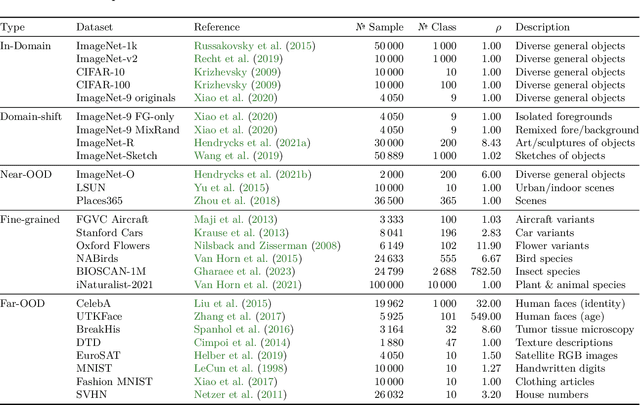
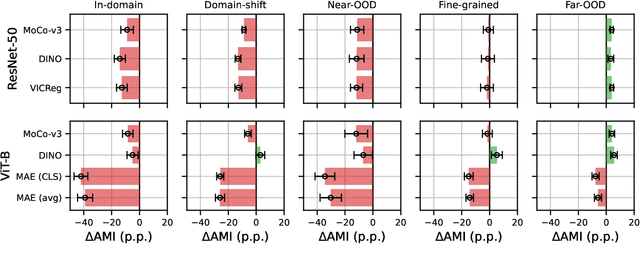
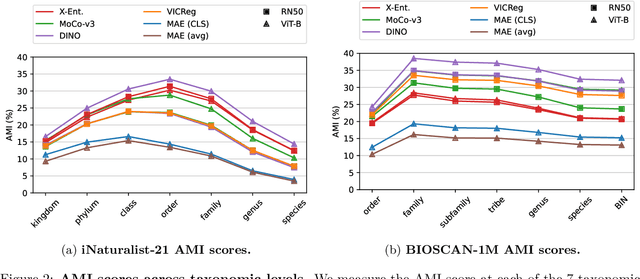
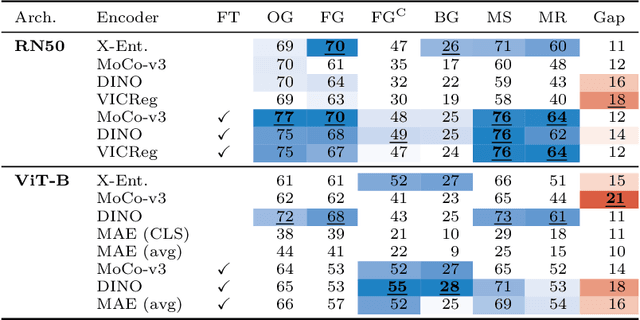
Abstract:Can pretrained models generalize to new datasets without any retraining? We deploy pretrained image models on datasets they were not trained for, and investigate whether their embeddings form meaningful clusters. Our suite of benchmarking experiments use encoders pretrained solely on ImageNet-1k with either supervised or self-supervised training techniques, deployed on image datasets that were not seen during training, and clustered with conventional clustering algorithms. This evaluation provides new insights into the embeddings of self-supervised models, which prioritize different features to supervised models. Supervised encoders typically offer more utility than SSL encoders within the training domain, and vice-versa far outside of it, however, fine-tuned encoders demonstrate the opposite trend. Clustering provides a way to evaluate the utility of self-supervised learned representations orthogonal to existing methods such as kNN. Additionally, we find the silhouette score when measured in a UMAP-reduced space is highly correlated with clustering performance, and can therefore be used as a proxy for clustering performance on data with no ground truth labels. Our code implementation is available at \url{https://github.com/scottclowe/zs-ssl-clustering/}.
BIOSCAN-CLIP: Bridging Vision and Genomics for Biodiversity Monitoring at Scale
May 27, 2024



Abstract:Measuring biodiversity is crucial for understanding ecosystem health. While prior works have developed machine learning models for the taxonomic classification of photographic images and DNA separately, in this work, we introduce a multimodal approach combining both, using CLIP-style contrastive learning to align images, DNA barcodes, and textual data in a unified embedding space. This allows for accurate classification of both known and unknown insect species without task-specific fine-tuning, leveraging contrastive learning for the first time to fuse DNA and image data. Our method surpasses previous single-modality approaches in accuracy by over 11% on zero-shot learning tasks, showcasing its effectiveness in biodiversity studies.
BarcodeBERT: Transformers for Biodiversity Analysis
Nov 04, 2023Abstract:Understanding biodiversity is a global challenge, in which DNA barcodes - short snippets of DNA that cluster by species - play a pivotal role. In particular, invertebrates, a highly diverse and under-explored group, pose unique taxonomic complexities. We explore machine learning approaches, comparing supervised CNNs, fine-tuned foundation models, and a DNA barcode-specific masking strategy across datasets of varying complexity. While simpler datasets and tasks favor supervised CNNs or fine-tuned transformers, challenging species-level identification demands a paradigm shift towards self-supervised pretraining. We propose BarcodeBERT, the first self-supervised method for general biodiversity analysis, leveraging a 1.5 M invertebrate DNA barcode reference library. This work highlights how dataset specifics and coverage impact model selection, and underscores the role of self-supervised pretraining in achieving high-accuracy DNA barcode-based identification at the species and genus level. Indeed, without the fine-tuning step, BarcodeBERT pretrained on a large DNA barcode dataset outperforms DNABERT and DNABERT-2 on multiple downstream classification tasks. The code repository is available at https://github.com/Kari-Genomics-Lab/BarcodeBERT
Which Tokens to Use? Investigating Token Reduction in Vision Transformers
Aug 09, 2023Abstract:Since the introduction of the Vision Transformer (ViT), researchers have sought to make ViTs more efficient by removing redundant information in the processed tokens. While different methods have been explored to achieve this goal, we still lack understanding of the resulting reduction patterns and how those patterns differ across token reduction methods and datasets. To close this gap, we set out to understand the reduction patterns of 10 different token reduction methods using four image classification datasets. By systematically comparing these methods on the different classification tasks, we find that the Top-K pruning method is a surprisingly strong baseline. Through in-depth analysis of the different methods, we determine that: the reduction patterns are generally not consistent when varying the capacity of the backbone model, the reduction patterns of pruning-based methods significantly differ from fixed radial patterns, and the reduction patterns of pruning-based methods are correlated across classification datasets. Finally we report that the similarity of reduction patterns is a moderate-to-strong proxy for model performance. Project page at https://vap.aau.dk/tokens.
A Step Towards Worldwide Biodiversity Assessment: The BIOSCAN-1M Insect Dataset
Jul 19, 2023Abstract:In an effort to catalog insect biodiversity, we propose a new large dataset of hand-labelled insect images, the BIOSCAN-Insect Dataset. Each record is taxonomically classified by an expert, and also has associated genetic information including raw nucleotide barcode sequences and assigned barcode index numbers, which are genetically-based proxies for species classification. This paper presents a curated million-image dataset, primarily to train computer-vision models capable of providing image-based taxonomic assessment, however, the dataset also presents compelling characteristics, the study of which would be of interest to the broader machine learning community. Driven by the biological nature inherent to the dataset, a characteristic long-tailed class-imbalance distribution is exhibited. Furthermore, taxonomic labelling is a hierarchical classification scheme, presenting a highly fine-grained classification problem at lower levels. Beyond spurring interest in biodiversity research within the machine learning community, progress on creating an image-based taxonomic classifier will also further the ultimate goal of all BIOSCAN research: to lay the foundation for a comprehensive survey of global biodiversity. This paper introduces the dataset and explores the classification task through the implementation and analysis of a baseline classifier.
MOTCOM: The Multi-Object Tracking Dataset Complexity Metric
Jul 20, 2022

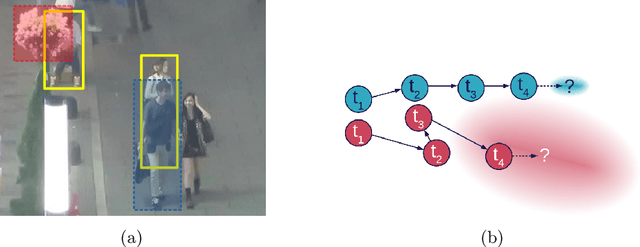

Abstract:There exists no comprehensive metric for describing the complexity of Multi-Object Tracking (MOT) sequences. This lack of metrics decreases explainability, complicates comparison of datasets, and reduces the conversation on tracker performance to a matter of leader board position. As a remedy, we present the novel MOT dataset complexity metric (MOTCOM), which is a combination of three sub-metrics inspired by key problems in MOT: occlusion, erratic motion, and visual similarity. The insights of MOTCOM can open nuanced discussions on tracker performance and may lead to a wider acknowledgement of novel contributions developed for either less known datasets or those aimed at solving sub-problems. We evaluate MOTCOM on the comprehensive MOT17, MOT20, and MOTSynth datasets and show that MOTCOM is far better at describing the complexity of MOT sequences compared to the conventional density and number of tracks. Project page at https://vap.aau.dk/motcom
Multi-Task Classification of Sewer Pipe Defects and Properties using a Cross-Task Graph Neural Network Decoder
Nov 15, 2021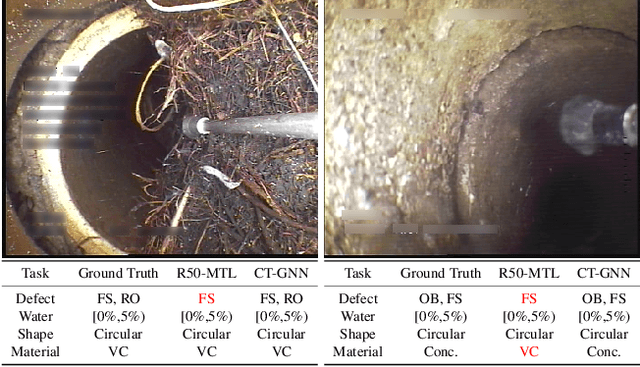
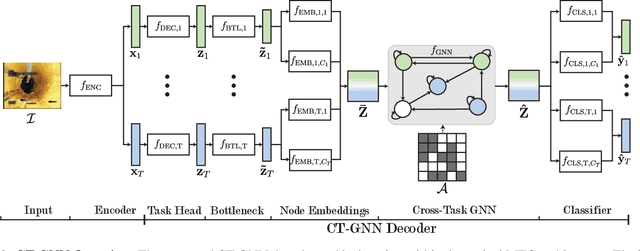

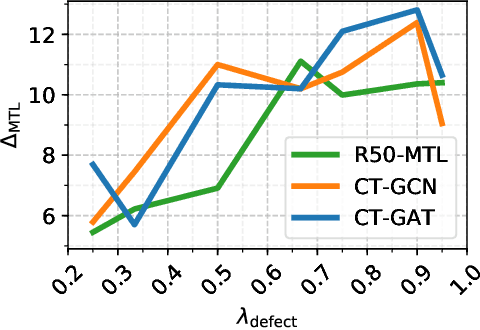
Abstract:The sewerage infrastructure is one of the most important and expensive infrastructures in modern society. In order to efficiently manage the sewerage infrastructure, automated sewer inspection has to be utilized. However, while sewer defect classification has been investigated for decades, little attention has been given to classifying sewer pipe properties such as water level, pipe material, and pipe shape, which are needed to evaluate the level of sewer pipe deterioration. In this work we classify sewer pipe defects and properties concurrently and present a novel decoder-focused multi-task classification architecture Cross-Task Graph Neural Network (CT-GNN), which refines the disjointed per-task predictions using cross-task information. The CT-GNN architecture extends the traditional disjointed task-heads decoder, by utilizing a cross-task graph and unique class node embeddings. The cross-task graph can either be determined a priori based on the conditional probability between the task classes or determined dynamically using self-attention. CT-GNN can be added to any backbone and trained end-to-end at a small increase in the parameter count. We achieve state-of-the-art performance on all four classification tasks in the Sewer-ML dataset, improving defect classification and water level classification by 5.3 and 8.0 percentage points, respectively. We also outperform the single task methods as well as other multi-task classification approaches while introducing 50 times fewer parameters than previous model-focused approaches. The code and models are available at the project page http://vap.aau.dk/ctgnn
Sewer-ML: A Multi-Label Sewer Defect Classification Dataset and Benchmark
Mar 19, 2021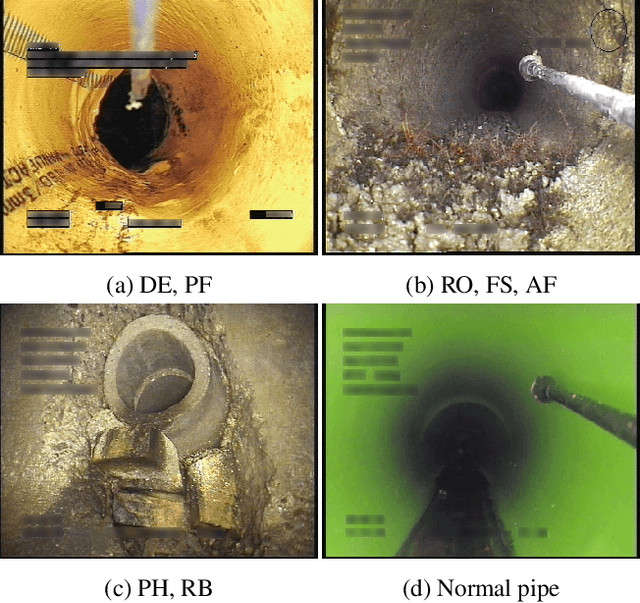
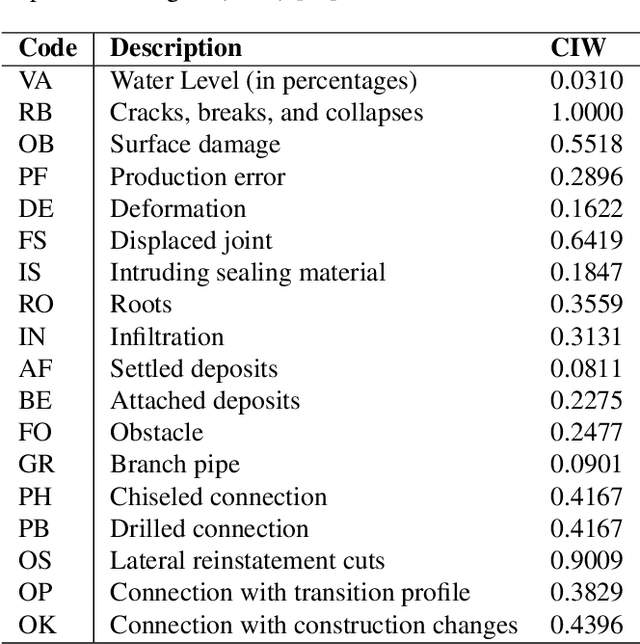

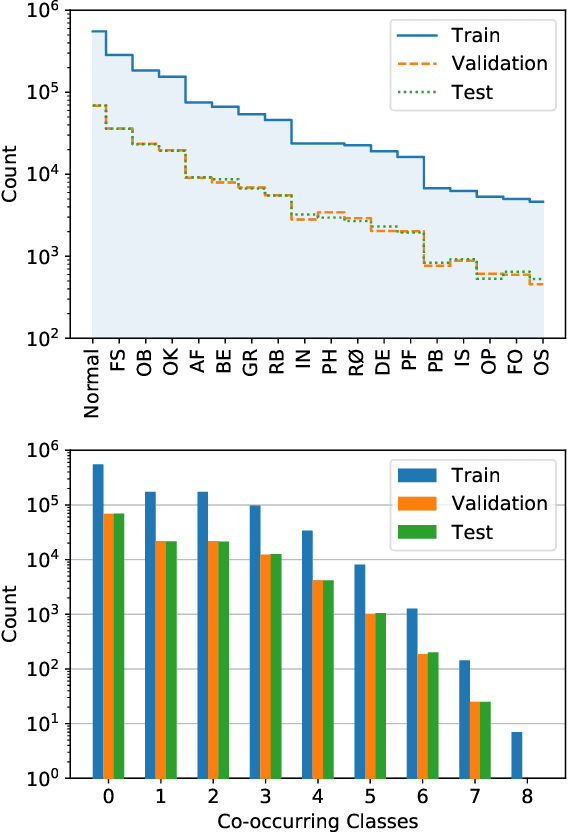
Abstract:Perhaps surprisingly sewerage infrastructure is one of the most costly infrastructures in modern society. Sewer pipes are manually inspected to determine whether the pipes are defective. However, this process is limited by the number of qualified inspectors and the time it takes to inspect a pipe. Automatization of this process is therefore of high interest. So far, the success of computer vision approaches for sewer defect classification has been limited when compared to the success in other fields mainly due to the lack of public datasets. To this end, in this work we present a large novel and publicly available multi-label classification dataset for image-based sewer defect classification called Sewer-ML. The Sewer-ML dataset consists of 1.3 million images annotated by professional sewer inspectors from three different utility companies across nine years. Together with the dataset, we also present a benchmark algorithm and a novel metric for assessing performance. The benchmark algorithm is a result of evaluating 12 state-of-the-art algorithms, six from the sewer defect classification domain and six from the multi-label classification domain, and combining the best performing algorithms. The novel metric is a class-importance weighted F2 score, $\text{F}2_{\text{CIW}}$, reflecting the economic impact of each class, used together with the normal pipe F1 score, $\text{F}1_{\text{Normal}}$. The benchmark algorithm achieves an $\text{F}2_{\text{CIW}}$ score of 55.11% and $\text{F}1_{\text{Normal}}$ score of 90.94%, leaving ample room for improvement on the Sewer-ML dataset. The code, models, and dataset are available at the project page https://vap.aau.dk/sewer-ml/
 Add to Chrome
Add to Chrome Add to Firefox
Add to Firefox Add to Edge
Add to Edge